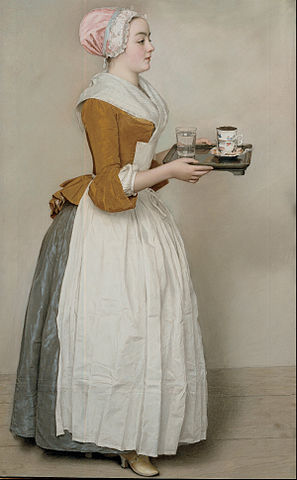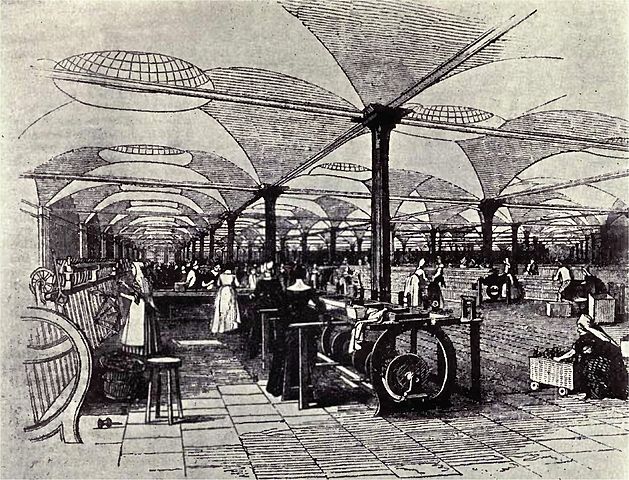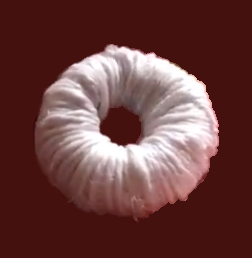Paid Employment for Women in the 18th and 19th Centuries
Housemaid, hand-spinner or blacksmith?
Note: much of the information in this article comes from the excellent Gender, Work and Wages in Industrial Revolution Britain by Joyce Burnette.
During the Industrial Revolution, the vast majority of women held paid employment for at least some part of their lives. Sometimes that employment ended with marriage, and sometimes it did not. Many worked for wages in agriculture, manufacturing or domestic service, while others ran small businesses. Women assisted their husbands as equal partners in the management of farms, public houses, shops, and other enterprises, taking over sole running of the business when they were widowed.
I'm principally interested in the late 18th century and the Regency period, but some of the statistics I quote here cover the first half of the 19th century, since the 1841 census was the first to include questions on occupational status. Even then, only the occupation of the male head of household was listed. This is symptomatic of a general problem we encounter when looking for statistics on women's work in previous centuries. In the case of married business partners, only the husband's name is listed in trade directories. In census data, women are often listed as having no occupation even when they were in paid employment, since census takers were instructed only to record data on the household's main breadwinner. These omissions can come to light via indirect evidence. For example, if a quarry is documented as having a dozen female employees, and yet no women in the district are recorded as stone workers, we know they have been omitted from the written record.
Nevertheless, there is no shortage of documentary evidence of women's work, from diaries, account books, court proceedings, trade directories, newspaper articles, reports from parliamentary select committees, and so on.
So what employment opportunities were available to women in the Georgian and Victorian periods?
Domestic service, agriculture and manufacture each accounted for roughly 30% of employed women, followed by dealing (i.e. commerce) at 11%, according to Higgs's revised figures based on the 1841 census. Let's take a look at some of the occupations open to women.
Agriculture: Farmer
The term 'farmers', as opposed to 'farm servants', referred to people who ran a farm on land they owned or rented, usually with the assistance of hired workers or family members. Many women managed farms and employed farm labourers in their own right, without a male head of household. Most but not all of these were widows. Across Britain in the 18th and 19th centuries, census data and other written records attest to 5% to 10% of farmers being female, and this is in addition to those women whose occupation was not recorded because they ran their farm with a husband, father or brother.
Agriculture: Farm servant or day labourer
Many farm servants were hired annually, living with the farmer and his or her family. Others were labourers hired and paid by the day. Men outnumbered women by a large margin among day labourers, but almost half of annual servants were female. They performed a wide variety of tasks, including hay-making, stone-picking, and helping with lambing.

Domestic service
Housemaids, kitchenmaids and housekeepers are among the working women we most often see in contemporary and historical fiction, film and TV. And indeed, the domestic service sector employed a large proportion of all women in paid work in this period: somewhere between 20% and 50%, depending on how one counts. Live-in female domestic servants were almost exclusively single and generally young, while charwomen and laundresses often lived in their own homes and were more likely to be married.
Shopkeeper
Shopkeepers appear in historical records under many names, reflecting the wide variety of goods sold. These include "grocer", "tea-dealer", "mercer", "dealer in groceries", "haberdasher and dealer in smallwares", "linen draper and silk mercer", and "fruiterer and greengrocer". Many of these small businesses were run by married couples, and a small but non-negligible proportion were run by women alone.
Publican
As with shops, inns and taverns were often run by husband-and-wife teams, and occasionally by widows or other single women.
Lace-maker
In the 18th century, many women worked in their own homes making bobbin or pillow lace, which is lace made by hand using a lace pillow, a padded surface covered in bobbins around which the thread is wound. In the 19th century, however, these were edged out by factory-made or imported lace.
Milliner
Milliners make, trim and sell women's hats. In this trade, women outnumbered men twenty-to-one in the early 19th century.
Straw-bonnet maker
Straw-plaiting and bonnet making is another trade where women outnumbered men by a large margin.
Glover
Often, men cut out leather gloves while women sewed them up. Later in the century, fashions changed, and knitted and imported gloves became more popular.
Screw-maker, pin-maker and other manufacturing jobs
The majority of early 19th-century screw-makers and pin-makers were female. Many women also worked in earthenware manufacture, painted pottery, and were employed in paper mills, to cite just some examples.
Schoolmistress
In the educational sector, near-equal numbers of men and women were employed, though women's wages were significantly lower than men's. Women worked as school owners and managers, schoolmistresses, and governesses. The establishments they worked in ranged from expensive boarding schools for the daughters of gentlemen, to village dame schools whose owner charged a few pence a week for what was basically a babysitting service.

Hand-spinner
Spinning wool into yarn was one of the most common occupations for women in the 18th century, but the invention of the water frame, the spinning jenny and the mule in the 1760s and 1770s put paid to hand-spinning. Although women could operate these new machines, the larger mules required so much strength that they were confined to men in their twenties and thirties.
Handloom weaver
Handloom weaving was a relatively unskilled occupation, easy to learn. Towards the end of the 18th century, therefore, many women who could no longer find spinning work took up handloom weaving instead. However, the technology was in its turn replaced by the power-loom, and by the middle of the 19th century, handloom weaving had almost died out as an occupation.
Business owner
Women worked as pawnbrokers and timber dealers, ran stonemason's yards, and owned linen mills.
Many businesswomen also worked as "middlemen". In cottage industries, the "middleman" typically farmed out the work to individual employees, such as button-makers, lace-makers or handloom weavers. Some of these middlemen were in fact women, particularly in female-dominated sectors such as the lace trade.
Factory manager or overlooker
As Britain became more industrialised, and cottage industry gave way to the factory system, a growing number of overlookers were needed. These were generally men, but some women also occupied these posts.

Button-maker
The making of wire buttons was a significant cottage industry in the 18th and early 19th centuries, particularly in Dorset. These wire buttons or thread buttons were made by wrapping thread around a brass ring.
Miner
Thousands of women were employed in Cornish copper and tin mines in the early 19th century, usually above ground. In the Lancashire coal mines, men outnumbered women twelve-to-one underground. However, women were certainly not absent from the mines, even after the Mines Act of 1842 forbade the employment of women underground.
Other artisans
Documented examples exist of 18th or 19th-century women working as butchers, carters, coopers, iron-casters, brickmakers, clock-menders, and even blacksmiths.